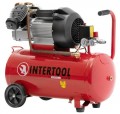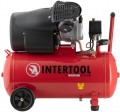Input performance
The amount of air that the compressor is able to process per unit of time; usually stated in liters per minute. Performance, along with pressure (see below), is one of the most important parameters: it is it that primarily determines how compatible the compressor will be with one or another pneumatic tool.
It is worth choosing a model according to this indicator in such a way that it can be guaranteed to “pull out” all the tools that can be connected at the same time. Air consumption is usually directly indicated in the characteristics of each tool, and it is quite simple to calculate the total requirement. However, due to the design features, the compressor must have a certain performance margin; the specific value of this stock depends on a number of nuances.
The main point is that some companies indicate for their units the performance at the outlet (how much air is supplied to the tool), while others indicate at the inlet (how much air the compressor sucks in). Since no compressor is perfect, part of the air is inevitably lost during the compression process, so the amount of air at the outlet will always be less than at the inlet. Accordingly, if the output performance is indicated in the characteristics, a margin of 10-20% is recommended, and if the input is 35-40%.
There are also more complex techniques that allow you to more accurately derive the required performance depending on the characteristics of specific tools; they can be found in...special sources.
Power
The power of the engine installed in the compressor. It is not the main parameter in evaluating the efficiency of the device — here the performance and nominal pressure play a decisive role (see above), and the engine is selected in such a way that its power is sufficient to ensure the claimed characteristics. However, this indicator still has practical significance: in compressors with an electric motor (and there are now most of them; see “Engine type”), the engine power determines the total energy consumption of the device, as well as the requirements for the network where it is planned to connect it (for more details, see “Voltage networks"). In addition, the power of the engine (regardless of its type) must be known in order to calculate the optimal performance value using some special formulas.
For internal combustion engines, power is traditionally expressed in horsepower (hp); you can convert it to watts in this way: 1 hp. = 735 W.
Power
The power of an internal combustion engine installed in a compressor of the appropriate design (see "Type" above), expressed in horsepower.
For the power value in general, see the relevant paragraph below. Here we note that in modern technology, the universal unit of power used for all types of engines is watts. However, horsepower has traditionally been and continues to be used to characterize internal combustion engines, and some users are more comfortable judging power by this designation. Therefore, for models with internal combustion engines, the equivalent power in hp is often also indicated.
Convert watts to hp and vice versa is quite simple: 1 hp. approximately equal to 735 watts.

